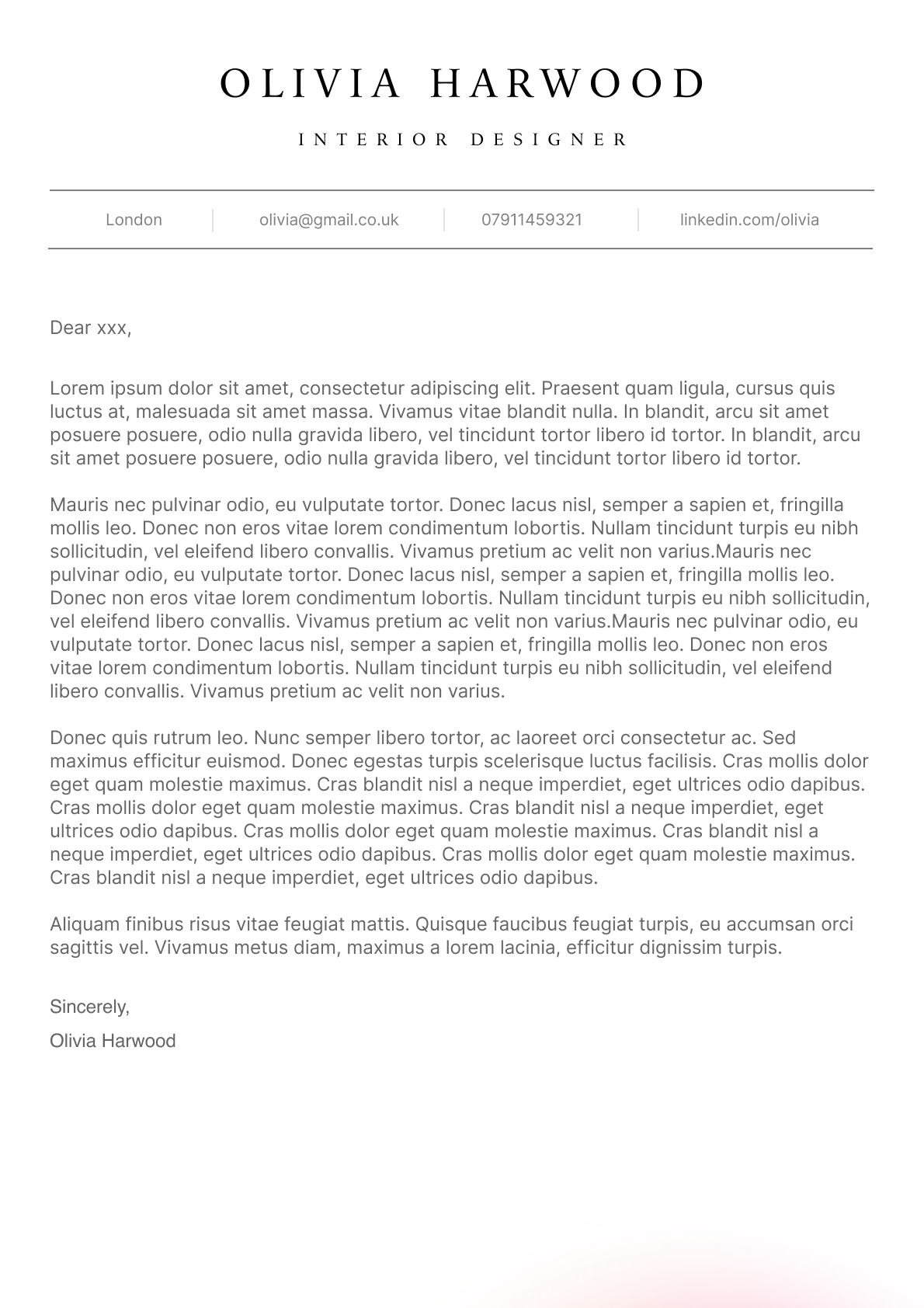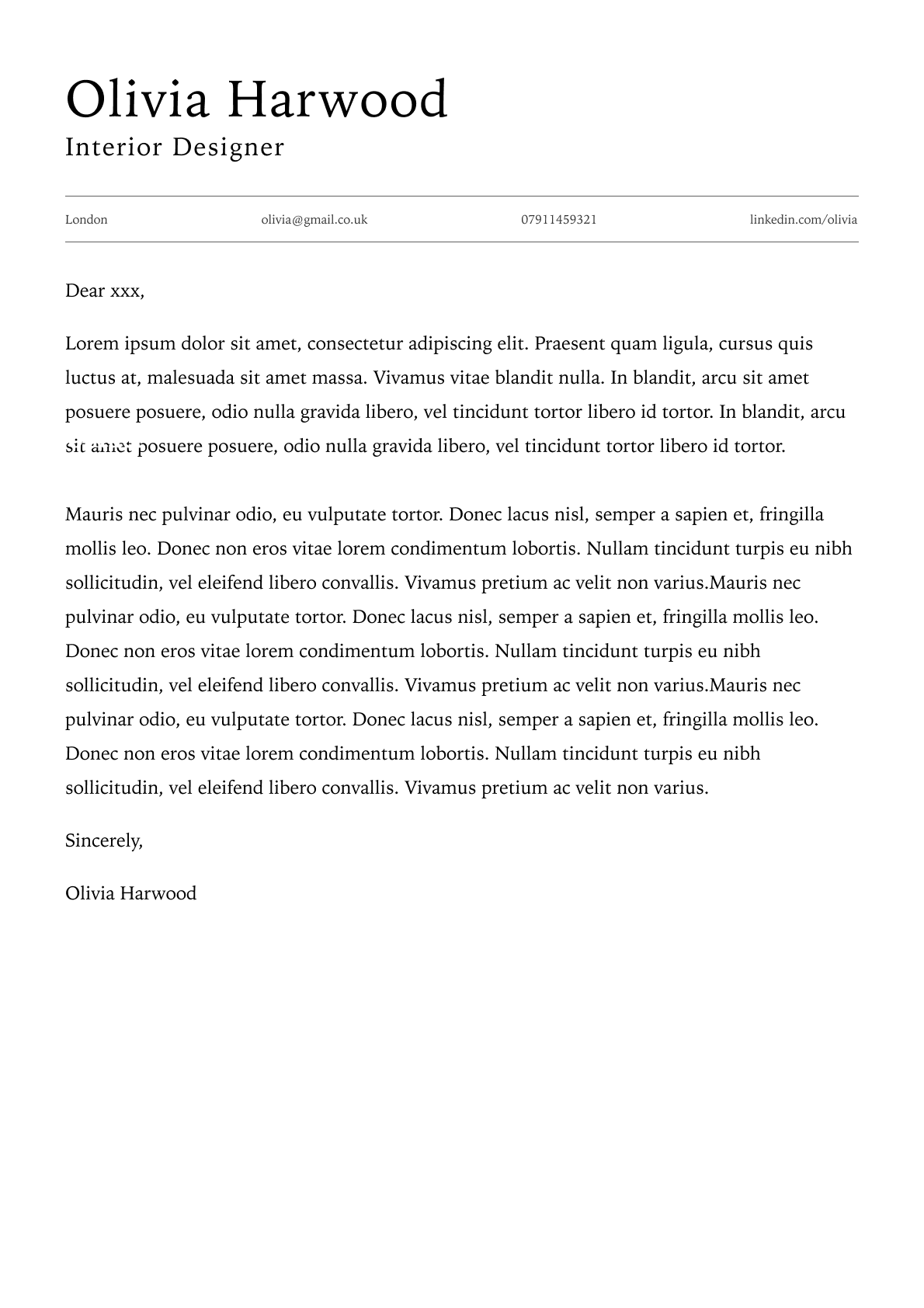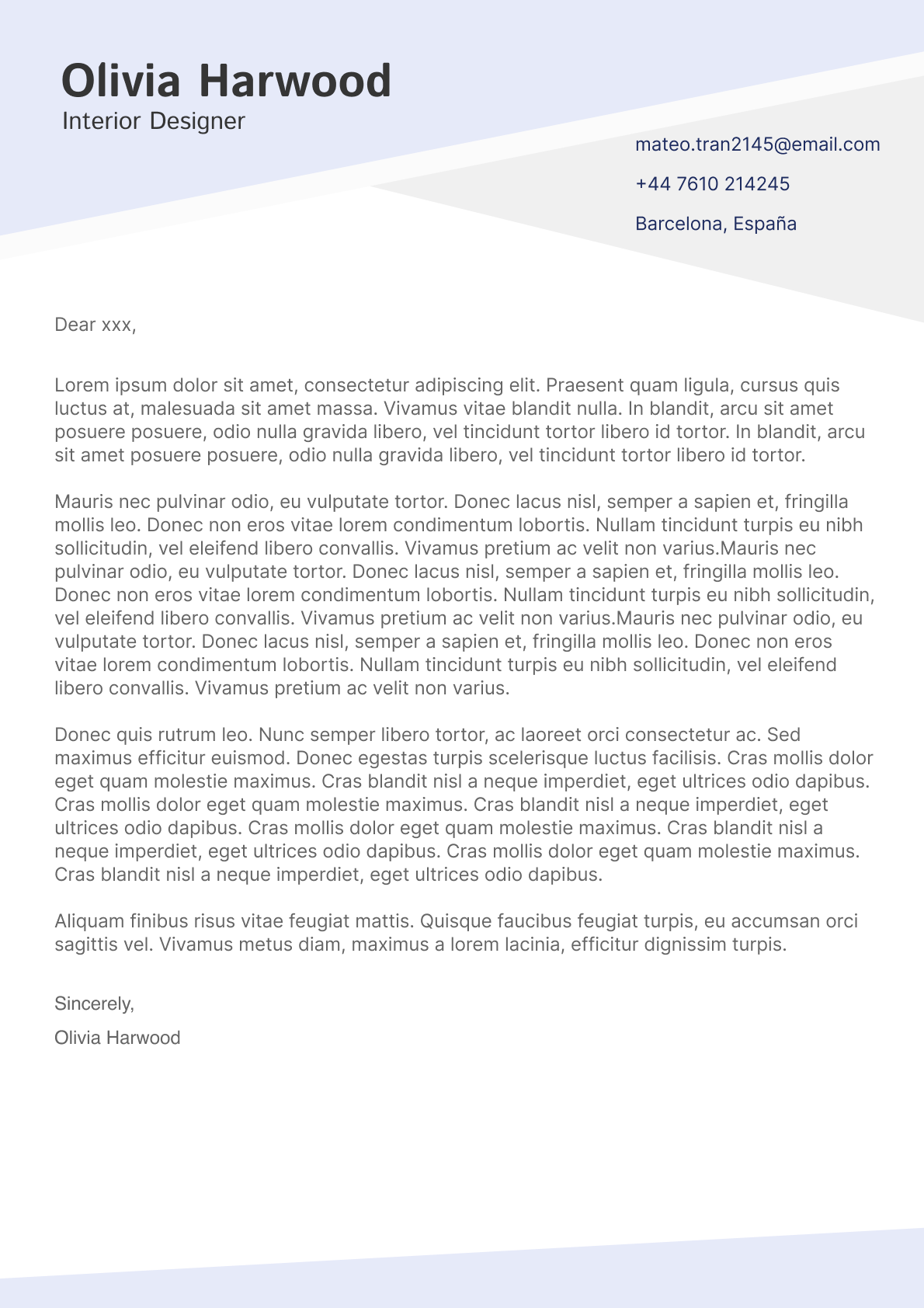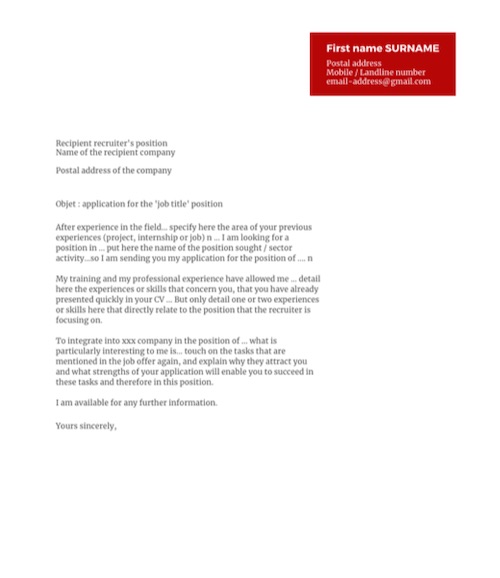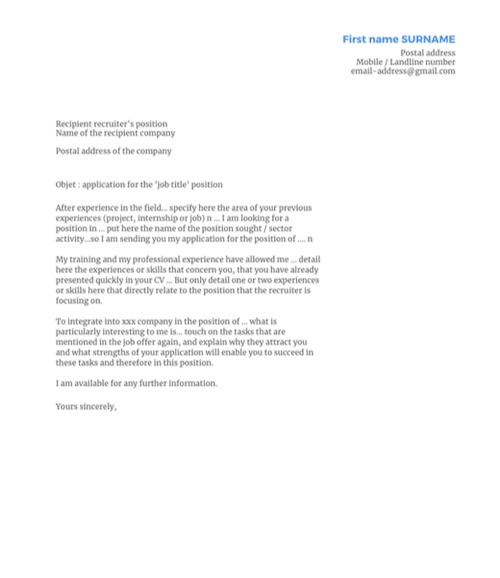How to write a cover letter
The cover letter is the essential document that accompanies your resume. It allows you to stand out and get an interview. ToolResume gives you the keys to write an effective cover letter and offers you customizable templates.
Create your cover letterWhat is a cover letter?
The purpose of the cover letter is to introduce yourself, to explain to the recruiter who you are by completing the information appearing on your resume without repeating it. It's about highlighting your experience, your strengths, but also your personality, to convince your interlocutor that you are the person they are looking for. Knowing that a recruiter spends an average of 30 seconds on a cover letter, it is essential to take care of both content and form to retain their attention, as these two elements already say a lot about you.
To structure an effective cover letter, the "you", "me" and "we" rule has proven itself and is expected by most recruiters.
Talk about the company
In the first paragraph of your letter, it is recommended to start with "you", meaning the company. Show that your application is motivated by specific elements of the company and its organization.
You should avoid generic formulas, factual citations, and references unrelated to the position.

Talk about yourself
The second paragraph is when you detail your background and highlight your profile.
It is important to prove that you are the ideal candidate for the position using concrete examples that demonstrate your skills and qualities mentioned in the job posting.

Talk about your future collaboration
This final part is an opportunity to project yourself into a future collaboration.
The goal is to show what you can bring to the company and how the collaboration will contribute to the smooth operation of a service or the success of a project.
Don't forget, the letter should conclude by encouraging the recruiter to meet you for an interview.

Is it still useful?
In the age of mobile job search applications, it's legitimate to ask the question. However, skipping the cover letter would be a mistake, as most employers still rely on this document to make an initial selection among candidates. Indeed, faced with two equivalent resumes, it's the cover letter that will make the difference. It would be a shame to miss out on an interview because of a poorly presented, poorly written... or not written at all cover letter.
How to structure your cover letter?
Structure is important in writing a cover letter, as it follows certain rules that recruiters expect: after the greeting, it begins with a catchphrase announcing the body of the text in three parts (the famous "you, me, we") and ends with a concluding sentence and polite formulas.
The greeting is the "Dear Sir/Madam" that introduces your letter. Don't hesitate to personalize it if you know the title or name of your contact, but be careful to write it correctly. Nothing more vexing than a misspelled last name!
The catchphrase indicates in a few words the purpose of your approach. You can take the opportunity to stand out with a striking formula, however use originality with caution. Make sure to maintain a professional tone and avoid too personal references if you want to be taken seriously.
Examples: Your job posting for a position as […] caught my attention and I am therefore submitting my application.
Wishing to give a new impetus to my career, I am very interested in the position of […] to be filled within your company.
The body of the text
1. The "you", show that you are not applying by chance.
This is the part that the recruiter will read first and that will give them, or not, the desire to know more. You must therefore pay particular attention to it. The goal is to demonstrate that you know the company and that your application is motivated by elements of its organization, its values or its current events. To do this, take the time to inform yourself about the company by consulting its website for example. The goal is to retain one or two topics that show your affinities with your future employer, the targeted position or its business sector.
Example: I learned in the press that your establishment planned to expand its offer by opening a pastry counter, and I am particularly sensitive to your eco-responsible approach that prioritizes artisanal production, organic and local raw materials.
Mistakes to avoid:
- Using catch-all formulas like: "I wish to join your company, market leader in its sector".
- Citing factual or general elements like "Your company, founded in 1895 in Bordeaux..." or "Energy renovation is a promising sector with a bright future...". Your interlocutor already knows this, and it doesn't teach them anything about your profile.
- Overloading your text with references unrelated to your skills or the desired position.
2. The "me", prove that you are the ideal candidate for the position.
Carefully analyze the job posting text to understand the needs and expectations of the employer and show how you can meet them through concrete examples. Without paraphrasing your resume, detail one or two situations where you have been able to implement the skills sought by the recruiter. To do this, use action verbs, highlight your successes, if possible with quantified examples.
Example: My experience in the hotel industry has allowed me to acquire skills in team management and customer relations. As director of the […] hotel, in addition to leading a team of fifteen people for five years, I demonstrated my management qualities by contributing to achieve 15% savings on the budget devoted to site overhead costs.
Personal qualities such as autonomy, flexibility, creativity or interpersonal skills are highly valued by companies. Don't forget to highlight them by illustrating them with examples from your professional or personal activities, such as your experience as a basketball team coach that highlights your team spirit.
If you are an inexperienced candidate, or in career transition, the cover letter is particularly useful to explain your professional project to the recruiter. Indeed, if you don't have experience directly corresponding to the position sought, you can make the link with skills acquired during your studies (internships, training, thesis) or missions carried out in other business sectors. Show that your application is part of a carefully thought-out professional project and bet on your enthusiasm, your willingness to learn and progress within the company.
Mistakes to avoid:
- Asserting your qualities without supporting them with examples.
- Copying your resume without deepening it.
- Mentioning bad relationships with a former employer or denigrating them.
- Mentioning details of your personal life unrelated to the position (age, family situation, number of children).
- Saying how long you've been looking for a job.
3. The "we", project yourself into the future collaboration.
Help the recruiter imagine you in their team by explaining what you can bring to the company and how your collaboration will contribute to the smooth running of a service or the success of a project. This is the time to convey key messages summarizing your main qualities.
Example: Having already supervised the creation of a quality service, you can rely on my technical knowledge in engineering and my dynamism in team management to successfully develop a quality control policy common to all your subsidiaries.
The concluding sentence. Before ending, encourage the recruiter to meet you in an interview by indicating that you are at their disposal for any additional information. Show confidence in yourself and avoid too hesitant turns of phrase.
Example: I will be happy to make myself available to meet you and discuss ways to effectively optimize your computer system.
Polite formulas. They are often neglected while they are essential to end a letter with courtesy. No need to rack your brains, you just need to choose one among the established formulas while being careful to use the same denomination as in the greeting.
Example: Yours sincerely, Dear Sir/Madam, my best regards/my distinguished regards/my respectful regards.

And about the form?
As recruiters spend little time on each letter, it is essential to take care of the layout. Opt for a clear and airy presentation. Select a simple and readable font like Arial, Calibri or Times New Roman in size 10 to 12 points.
The header must include your contact information on the left (name, first name, address, phone number and email address) and those of the recipient on the right. Don't forget to indicate the job title and its reference in the subject line.
In terms of style, be direct, your letter must fit on one page. Write short, concise sentences and adopt a neutral and professional tone. Colloquial or too pompous language is to be avoided.
Mastery of spelling remains an important criterion for recruiters. Don't rely on automatic spell checkers which are not always reliable. Proofread yourself, or have someone proofread you, carefully to not let any mistakes slip through.
You will have understood, the secret of a good cover letter is personalization. Out of the question to send copy-paste of the same letter to all employers. If you start from a general template, take the trouble to adapt its content for each position you apply for.
You're still hesitating to get started?
To be sure not to make a mistake, :siteName offers you a wide range of customizable letters. Our pre-formatted templates declined by type of job and business sector will save you time. You just have to complete them!
In summary:
- The cover letter bridges the gap between your resume and the targeted position.
- It allows you to demonstrate that you know your future employer and that your profile matches their expectations through concrete examples from your experience.
- It must complement your resume without repeating it, be concise, well presented and contain no spelling mistakes.
Cover Letter Templates
ToolResume offers you a wide range of customizable letters. Our ready-to-use templates will save you time.
Frequently asked questions about cover letters
Creating a cover letter is not an easy exercise. We answer your questions to write a cover letter adapted to your needs.
What is a cover letter?
A cover letter is a complementary document that allows you to show your motivations to an employer. It should highlight your experience, strengths, and personality to convince the recruiter that you are the person they are looking for.
Why is it important to take care of the cover letter?
A recruiter spends an average of 30 seconds on a cover letter, so it is essential to take care of both content and form to retain their attention and stand out.
How to structure your cover letter?
The cover letter follows certain rules that recruiters expect: it begins with a greeting, followed by an opening sentence introducing the body of the text in three parts ("you, me, us") and ends with a concluding sentence and a polite closing.
How to start your cover letter?
Start with "you", meaning the company. Show that your application is motivated by specific elements of the company and its organization.
What should be included in the "me" part of the cover letter?
In the second paragraph, detail your background and highlight your profile. It is important to prove that you are the ideal candidate for the position using concrete examples that demonstrate your skills and qualities mentioned in the job posting.
What should be included in the "us" part of the cover letter?
For this final part, project yourself into a future collaboration with the company. The goal is to show what you can bring to the company and how the collaboration will contribute to the smooth operation of a service or the success of a project.
Is it still useful to write a cover letter?
Yes, skipping the cover letter would be a mistake, as the majority of employers continue to rely on this document to make an initial selection among candidates. When faced with two equivalent resumes, it's the cover letter that will make the difference.
